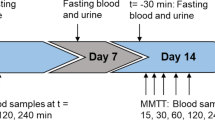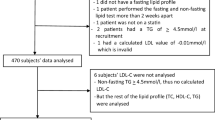Abstract
Objectives:
The aim of this study was to examine the variation of enterolactone from fasting and non-fasting blood of middle-aged healthy women eating a normal diet to determine the usefulness of a single sample in epidemiological studies.
Subjects and methods:
Twenty-six women born between 1940 and 1950 were recruited within the Malmö Diet and Cancer cohort. Three non-fasting and two overnight fasting samples were collected from each individual during a 5-week period. Twenty-one participated in all measurements. Enterolactone concentrations were analyzed by time-resolved fluoroimmunoassay.
Results:
The within-subject and between-subject variations (coefficient of variations, CV) were estimated to 59 and 89% respectively for fasting samples and 71 and 67% for non-fasting samples. The intraclass correlation coefficients (ICC) were estimated to 0.66 (95% confidence interval (CI) 0.35–0.84) for fasting and 0.48 (95% CI, 0.22–0.72) for non-fasting samples.
Conclusions:
Although the estimated ICC for blood samples was moderate, it indicates that enterolactone levels of both fasting and non-fasting blood samples should be useful in future projects within the Malmö Diet and Cancer cohort.
This is a preview of subscription content, access via your institution
Access options
Subscribe to this journal
Receive 12 print issues and online access
$259.00 per year
only $21.58 per issue
Buy this article
- Purchase on Springer Link
- Instant access to full article PDF
Prices may be subject to local taxes which are calculated during checkout

Similar content being viewed by others
References
Adlercreutz H (2002). Phyto-oestrogens and cancer. Lancet Oncol 3, 364–373.
Adlercreutz H, Fotsis T, Lampe J, Wahala K, Makela T, Brunow G et al. (1993). Quantitative determination of lignans and isoflavonoids in plasma of omnivorous and vegetarian women by isotope dilution gas chromatography-mass spectrometry. Scand J Clin Lab Invest Suppl 215, 5–18.
Adlercreutz H, Fotsis T, Watanabe S, Lampe J, Wahala K, Makela T et al. (1994). Determination of lignans and isoflavonoids in plasma by isotope dilution gas chromatography-mass spectrometry. Cancer Detect Prev 18, 259–271.
Adlercreutz H, Hockerstedt K, Bannwart C, Bloigu S, Hamalainen E, Fotsis T et al. (1987). Effect of dietary components, including lignans and phytoestrogens, on enterohepatic circulation and liver metabolism of estrogens and on sex hormone binding globulin (SHBG). J Steroid Biochem 27, 1135–1144.
Adlercreutz H, Wang GJ, Lapcik O, Hampl R, Wahala K, Makela T et al. (1998). Time-resolved fluoroimmunoassay for plasma enterolactone. Anal Biochem 265, 208–215.
Berglund G, Elmstahl S, Janzon L, Larsson SA (1993). The Malmo Diet and Cancer Study. Design and feasibility. J Intern Med 233, 45–51.
Bowey E, Adlercreutz H, Rowland I (2003). Metabolism of isoflavones and lignans by the gut microflora: a study in germ-free and human flora associated rats. Food Chem Toxicol 41, 631–636.
Clavel T, Henderson G, Alpert CA, Philippe C, Rigottier-Gois L, Dore J et al. (2005). Intestinal bacterial communities that produce active estrogen-like compounds enterodiol and enterolactone in humans. Appl Environ Microbiol 71, 6077–6085.
Hankinson SE, Manson JE, Spiegelman D, Willett WC, Longcope C, Speizer FE (1995). Reproducibility of plasma hormone levels in postmenopausal women over a 2–3-year period. Cancer Epidemiol Biomarkers Prev 4, 649–654.
Hausner H, Johnsen NF, Hallund J, Tetens I (2004). A single measurement is inadequate to estimate enterolactone levels in danish postmenopausal women due to large intraindividual variation. J Nutr 134, 1197–1200.
Heinonen S, Nurmi T, Liukkonen K, Poutanen K, Wahala K, Deyama T et al. (2001). In vitro metabolism of plant lignans: new precursors of mammalian lignans enterolactone and enterodiol. J Agric Food Chem 49, 3178–3186.
Johnsen NF, Hausner H, Olsen A, Tetens I, Christensen J, Knudsen KE et al. (2004). Intake of whole grains and vegetables determines the plasma enterolactone concentration of Danish women. J Nutr 134, 2691–2697.
Kilkkinen A, Pietinen P, Klaukka T, Virtamo J, Korhonen P, Adlercreutz H (2002). Use of oral antimicrobials decreases serum enterolactone concentration. Am J Epidemiol 155, 472–477.
Kilkkinen A, Stumpf K, Pietinen P, Valsta LM, Tapanainen H, Adlercreutz H (2001). Determinants of serum enterolactone concentration. Am J Clin Nutr 73, 1094–1100.
Lampe JW (2003). Isoflavonoid and lignan phytoestrogens as dietary biomarkers. J Nutr 133 (Suppl 3), 956S–964S.
Li JH, Awad AB, Fink CS, Wu YW, Trevisan M, Muti P (2001). Measurement variability of plasma beta-sitosterol and campesterol, two new biomarkers for cancer prevention. Eur J Cancer Prev 10, 245–249.
Milder IE, Arts IC, van de Putte B, Venema DP, Hollman PC (2005). Lignan contents of Dutch plant foods: a database including lariciresinol, pinoresinol, secoisolariciresinol and matairesinol. Br J Nutr 93, 393–402.
Missmer SA, Spiegelman D, Bertone-Johnson ER, Barbieri RL, Pollak MN, Hankinson SE (2006). Reproducibility of plasma steroid hormones, prolactin, and insulin-like growth factor levels among premenopausal women over a 2- to 3-year period. Cancer Epidemiol Biomarkers Prev 15, 972–978.
Penalvo JL, Haajanen KM, Botting N, Adlercreutz H (2005a). Quantification of lignans in food using isotope dilution gas chromatography/mass spectrometry. J Agric Food Chem 53, 9342–9347.
Penalvo JL, Heinonen SM, Aura AM, Adlercreutz H (2005b). Dietary sesamin is converted to enterolactone in humans. J Nutr 135, 1056–1062.
Rosner B, Spiegelman D, Willett WC (1992). Correction of logistic regression relative risk estimates and confidence intervals for random within-person measurement error. Am J Epidemiol 136, 1400–1413.
Stumpf K, Adlercreutz H (2003). Short-term variations in enterolactone in serum, 24-hour urine, and spot urine and relationship with enterolactone concentrations. Clin Chem 49, 178–181.
Stumpf K, Uehara M, Nurmi T, Adlercreutz H (2000). Changes in the time-resolved fluoroimmunoassay of plasma enterolactone. Anal Biochem 284, 153–157.
Stumpf K (2004). Serum Enterolactone as Biological Marker and in Breast Cancer: from Laboratory to Epidemiological Studies (dissertation). University of Helsinki: Helsinki.
Tarpila S, Aro A, Salminen I, Tarpila A, Kleemola P, Akkila J et al. (2002). The effect of flaxseed supplementation in processed foods on serum fatty acids and enterolactone. Eur J Clin Nutr 56, 157–165.
Tworoger SS, Hankinson SE (2006). Use of biomarkers in epidemiologic studies: minimizing the influence of measurement error in the study design and analysis. Cancer Causes Control 17, 889–899.
Vanharanta M, Voutilainen S, Lakka TA, van der Lee M, Adlercreutz H, Salonen JT (1999). Risk of acute coronary events according to serum concentrations of enterolactone: a prospective population-based case–control study. Lancet 354, 2112–2115.
Vanharanta M, Voutilainen S, Rissanen TH, Adlercreutz H, Salonen JT (2003). Risk of cardiovascular disease-related and all-cause death according to serum concentrations of enterolactone: Kuopio Ischaemic Heart Disease Risk Factor Study. Arch Intern Med 163, 1099–1104.
Vineis P (1997). Sources of variation in biomarkers. IARC Sci Publ 142, 59–71.
Zeleniuch-Jacquotte A, Adlercreutz H, Akhmedkhanov A, Toniolo P (1998). Reliability of serum measurements of lignans and isoflavonoid phytoestrogens over a two-year period. Cancer Epidemiol Biomarkers Prev 7, 885–889.
Acknowledgements
This study was sponsored by Swedish Council for Working Life and Social Research, Albert Påhlsson Foundation, Johanna Andersson Foundation, Swedish Research Council, Swedish Cancer Society, Regional Government of Skåne.
Author information
Authors and Affiliations
Corresponding author
Additional information
Contributors: ES, UE, EW and BG contributed to study design. ES conducted the analysis of data, and wrote most of the manuscript. All authors reviewed the final manuscript.
Rights and permissions
About this article
Cite this article
Sonestedt, E., Ericson, U., Gullberg, B. et al. Variation in fasting and non-fasting serum enterolactone concentrations in women of the Malmö Diet and Cancer cohort. Eur J Clin Nutr 62, 1005–1009 (2008). https://doi.org/10.1038/sj.ejcn.1602811
Received:
Revised:
Accepted:
Published:
Issue Date:
DOI: https://doi.org/10.1038/sj.ejcn.1602811
Keywords
This article is cited by
-
Plasma enterolactone and risk of prostate cancer in middle-aged Swedish men
European Journal of Nutrition (2018)
-
Analysis of prostate cancer association with four single-nucleotide polymorphisms from genome-wide studies and serum phyto-estrogen concentrations
Prostate Cancer and Prostatic Diseases (2012)



